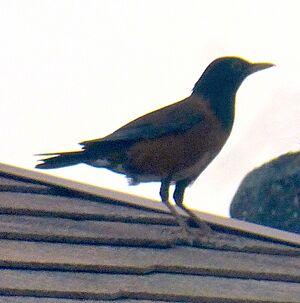Izu thrush facts for kids
Quick facts for kids Izu thrush |
|
|---|---|
 |
|
| Conservation status | |
| Scientific classification | |
| Genus: |
Turdus
|
| Species: |
celaenops
|
The Izu thrush is a special bird that lives only in Japan. It's part of the thrush family. You might also hear it called the Izu Islands thrush.
Contents
About the Izu Thrush
What Izu Thrushes Eat
Izu thrushes are not picky eaters! They enjoy munching on small animals like earthworms and insects. They also love fruits such as cherries and mulberries.
Reproduction and Life Cycle
Izu thrushes have their breeding season from March to July. During the first part of this time, male thrushes sing mostly at dawn. Later in the season, they sing all day long! Their song can sound like "kyurrr, chotts." Their calls might sound like "tweet" or "chat, chat, chat."
These birds build their nests in trees. They usually place them about half a meter (or about 20 inches) off the ground. They use materials like grass and moss. They even use soil to help hold the nest together!
A female Izu thrush usually lays three or four eggs. Sometimes she might lay two or even five eggs. The eggs are blue with brown spots. Each egg is about 3 centimeters (just over an inch) long. Both the mother and father thrush help to care for their young chicks.
Protecting Nests
Sadly, the number of young Izu thrushes that survive has gone down. This is because weasels were brought into their habitat. Weasels sometimes eat the eggs or young birds in the nests.
What the Izu Thrush Looks Like
The Izu thrush is about 23 centimeters (or 9 inches) long. This is about the length of a ruler. Their backs and tails are black. They have bright yellow rings around their eyes and a yellow beak. Their wings are brown, and their chest is a pretty rust-red color. Male Izu thrushes usually have darker feathers than the females.
Where Izu Thrushes Live
The Izu thrush is a bird that is found only in Japan. Most of them live on the Izu Islands. On islands like Izu Ōshima, Miyakejima, and Mikurajima, their song has two syllables.
However, on Hachijojima island, which is about 90 kilometers (56 miles) south, their song sounds very different. It has only one syllable! On Aogashima, the last island in the chain, their songs have even more syllables.
Some Izu thrushes also live on the Tokara Islands. These include Yakushima, Kuchinoshima, Nakanoshima, Tairajima, Akusekijima, and Takarajima. On Nakanoshima, their song also has more syllables. During winter, some Izu thrushes have been seen in other parts of Japan. These areas include Shizuoka, Chiba, Mie, and Wakayama Prefectures.
Protecting the Izu Thrush
The Izu thrush is considered a "vulnerable" species by the IUCN Red List. This means they are at risk of becoming endangered. There are between 2,500 and 9,999 adult Izu thrushes left. Their numbers are slowly going down.
Their homes are shrinking or becoming less suitable for them. They face threats from things like volcanoes, roads, and railroads. Wood plantations and tourist areas can also affect their habitat. Both native animals and new species that have been introduced can also be a danger to them. Diseases can also threaten the Izu thrush population.


